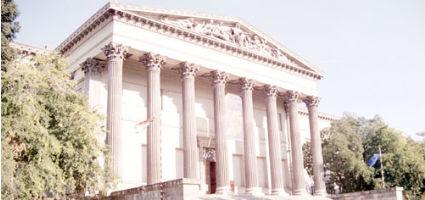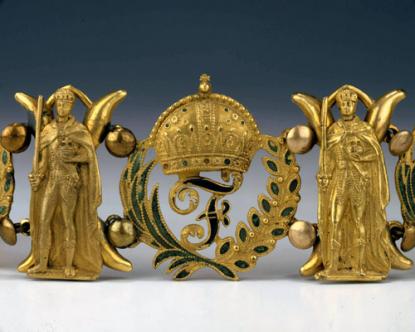2024. May 7. Tuesday
Hungarian National Museum - Budapest
 |
Address: 1088, Budapest Múzeum körút 14-16.
Phone number: (1) 338-2122
E-mail: info@hnm.hu
Opening hours: Tue-Sun 10-18
|
The exhibition has closed for visitors.
2004.03.19. - 2004.05.30.
Museum tickets, service costs:
|
Ticket for adults
|
1100 HUF
|
|
|
Ticket for students
|
550 HUF
|
|
|
Ticket for soldiers
|
550 HUF
|
|
|
Ticket for pensioners
|
550 HUF
|
|
|
Ticket for families
(2 adults + children)
|
1150 HUF
|
/ family
|
|
Individual guide
|
400 HUF
|
/ capita
|
|
Group guide
(max. 5 people)
|
1800 HUF
|
/ group
|
|
Group guide
(11-15 people)
|
6000 HUF
|
/ group
|
|
Group guide
(max. 15 people)
|
5500 HUF
|
/ group
|
|
Group guide
(16-25 people)
|
9700 HUF
|
/ group
|
|
Group guide
(1-5 people)
|
1500 HUF
|
/ capita
|
|
Group guide
(6-10 people)
|
13000 HUF
|
/ group
|
|
Group guide
(11-15 people)
|
16000 HUF
|
/ group
|
|
Group guide
(16-25 people)
|
24000 HUF
|
/ group
|
|
Group guide for students
(max. 25 people)
|
4500 HUF
|
/ group
|
|
Group guide for students
(max. 15 people)
|
6000 HUF
|
/ group
|
|
Group guide for students
(max. 25 people)
|
12000 HUF
|
/ group
|
The exhibited items come from the Hungarian National Museum's jewellery collection, which is a most outstanding one of its kind on a country-wide scale. This collection gave base for a selection of around 100 relics which covering the period from the end of the 16th century to the end of the 19th century can properly represent Hungarian jewellery wear. Relics coming from the treasury of aristocratic, rich landowners are predominant, though works which once adorned the well-off members of the bourgeoisie also appear.

In the first section of the exhibition 17th-century Hungarian and Transylvanian types of jewellery are mounted. They include outstanding works of art that have become the best-known works of Hungarian goldsmith's art during the course of the last one and a half centuries. Underpinning these masterpieces, however, are lesser-known works which - maybe unreasonably - were rarely put in the limelight. This section abounds in pendants and necklaces giving an insight into the wide-ranging goldsmith's techniques applied in the Early Modern Ages. The especially frequent use of enamelling for the decoration of jewellery is observable. 18th-century works show the continued existence of characteristic Hungarian types which had evolved by the end of the 16th century. Though, jewellery made in line with Western European "fashion trend" is also represented.
The elements of Early Modern aristocratic wear continued to play an important role in the subsequent years as well. Evolved gradually in the patriotic period of the first half of the 19th century, the peculiarly Hungarian formal wear having its roots in long-lived traditions was in fashion among the leading personalities of social and political life as far as the end of the Second World War. This formal wear is represented with two examples in the exhibition. Sets of jewellery matching this ceremonial wear came to appear in the first third of the 19th century, having its origin in 16th-17th century jewellery types. We have put on display several samples illustrating the practice that by combining parts of earlier made works, and then completing them, goldsmiths created Hungarian ceremonial jewellery corresponding to 19th-century taste. Peculiarly enough, these sets of jewellery were first of all to embellish men's splendid wear.
Works which became popular in the years following the 1848-49 War for Freedom tell about a unique encounter between jewellery and history. After the suppressed revolution patriots dressed for mourning and this grief manifested itself in women's jewellery and wear as well.
Several exhibited works come from the collection of Miklós Jankovich (1772-1846), one of the most significant Hungarian collectors. According to 19th-century tradition, a number of works are linked with notable historic personalities. A great part of them cannot be confirmed historically, nevertheless these pieces of jewellery familiarise the visitors with a segment of Hungarian history.

In the first section of the exhibition 17th-century Hungarian and Transylvanian types of jewellery are mounted. They include outstanding works of art that have become the best-known works of Hungarian goldsmith's art during the course of the last one and a half centuries. Underpinning these masterpieces, however, are lesser-known works which - maybe unreasonably - were rarely put in the limelight. This section abounds in pendants and necklaces giving an insight into the wide-ranging goldsmith's techniques applied in the Early Modern Ages. The especially frequent use of enamelling for the decoration of jewellery is observable. 18th-century works show the continued existence of characteristic Hungarian types which had evolved by the end of the 16th century. Though, jewellery made in line with Western European "fashion trend" is also represented.
The elements of Early Modern aristocratic wear continued to play an important role in the subsequent years as well. Evolved gradually in the patriotic period of the first half of the 19th century, the peculiarly Hungarian formal wear having its roots in long-lived traditions was in fashion among the leading personalities of social and political life as far as the end of the Second World War. This formal wear is represented with two examples in the exhibition. Sets of jewellery matching this ceremonial wear came to appear in the first third of the 19th century, having its origin in 16th-17th century jewellery types. We have put on display several samples illustrating the practice that by combining parts of earlier made works, and then completing them, goldsmiths created Hungarian ceremonial jewellery corresponding to 19th-century taste. Peculiarly enough, these sets of jewellery were first of all to embellish men's splendid wear.
Works which became popular in the years following the 1848-49 War for Freedom tell about a unique encounter between jewellery and history. After the suppressed revolution patriots dressed for mourning and this grief manifested itself in women's jewellery and wear as well.
Several exhibited works come from the collection of Miklós Jankovich (1772-1846), one of the most significant Hungarian collectors. According to 19th-century tradition, a number of works are linked with notable historic personalities. A great part of them cannot be confirmed historically, nevertheless these pieces of jewellery familiarise the visitors with a segment of Hungarian history.
